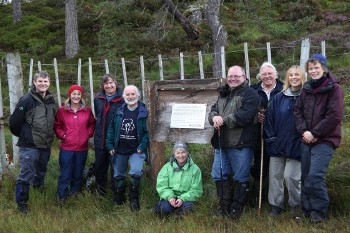
Glen Affric 20th anniversary event
This week the conservation charity marked the 20th anniversary of the forest restoration project in Glen
Affric which is being run jointly between the Forestry Commission and Trees for Life. The project is designed to boost the natural regeneration of the Caledonian Forest by excluding grazing deer.
Twenty years ago today, celebrity botanist David Bellamy formally closed the last gate on the 50-hectare exclosure containing over 100,000 naturally-occurring Scots pine seedlings. Since then, botanical surveys and fixed-point photography have shown how these trees and other plants have regenerated successfully in the absence of pressure from browsing deer.
Alan Watson Featherstone, Executive Director of Trees for Life, said: “The Coille Ruigh site, which has been left to regenerate naturally with no tree planting, is playing a crucial role in the restoration of Scotland’s ecological heritage. Regular surveys have given us invaluable knowledge and data about regeneration in the native pinewoods of the Caledonian Forest.”
Giles Drake-Brockman, Environment Manager for the Commission in Inverness, Ross and Skye, said: “This joint project between ourselves and Trees for Life has made an important contribution to the reshaping of Glen Affric. It tells a powerful story, showing how simple actions such as a fence to exclude deer can make the difference between open moorland and a naturally wooded landscape.”
Commenting on what has been achieved at Coille Ruigh, David Bellamy said: “Twenty years ago I was honoured to be asked to close a gate in a deer fence in Glen Affric. The result was astounding for the native trees and all the other plants and wildlife, thanks to the vision and hard work of Trees for Life and Forestry Commission Scotland. Well done!”
Where the ground conditions at the site are good, the growth of young pines has been superb, with Scots pines now up to seven metres tall and producing cones each year. Rowans and birches are also regenerating well, and plants including heather, blaeberry, eared willow, juniper and creeping ladies tresses are all recovering. The site is also a habitat for crested tits, a characteristic bird of the native pinewoods, and black grouse.
